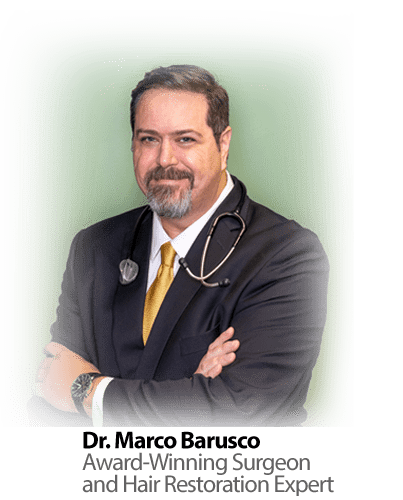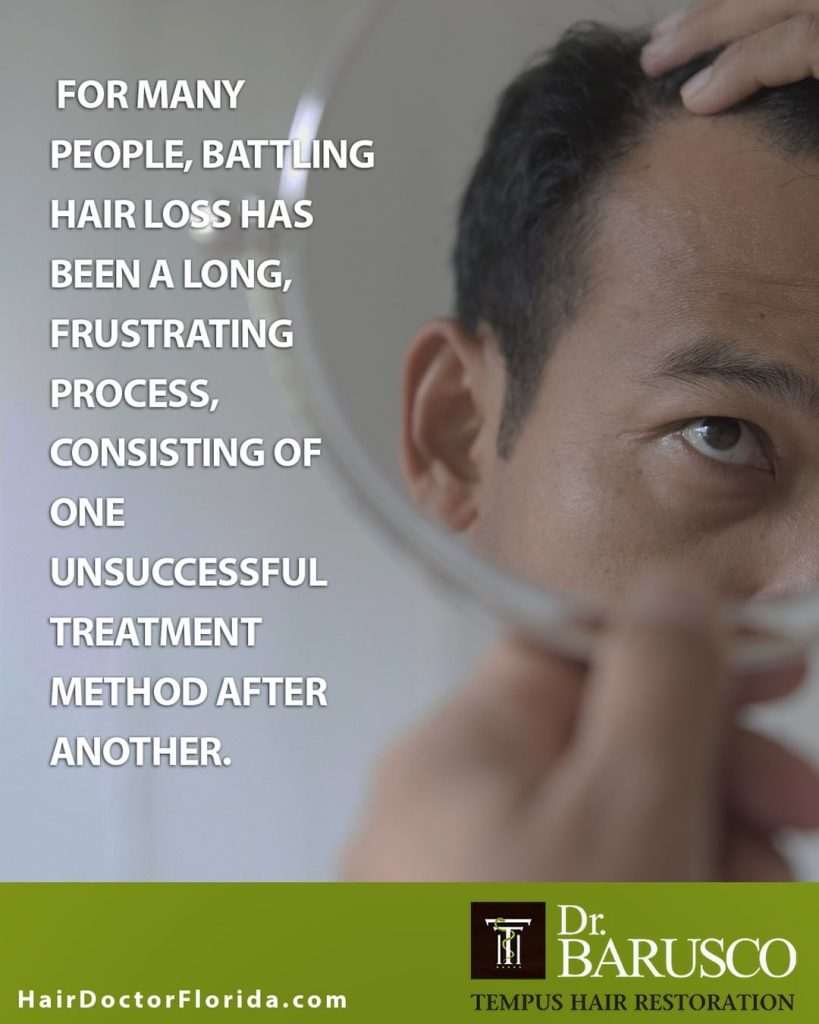If you have questions about hair restoration procedures, Dr. Marco Barusco—Founder and Chief Medical Officer of Tempus Hair Restoration—has answers! As a leading surgeon in this field, Dr. Barusco is a vocal advocate for consumer education, providing free resources for all who want to learn about hair transplants to get the objective information they need in order to make an informed decision.
Toward this end, Dr. Barusco’s YouTube channel—Hair Loss Medical Advice—features videos in which he answers viewers’ questions. We’ve chosen five that focus on issues that may not immediately come to mind when thinking about hair transplantation, but are certainly worth addressing! Read, watch and learn!
- How many hair grafts are necessary to restore a hairline?
The viewer who sent this question provided three photos of his hairline, showing temporal recession on both sides. He would learn that there is no across-the-board number. The circumstances the viewer outlined in his question helped determine Dr. Barusco’s response. For example, the viewer reported that he had been using finasteride with good results, then added oral minoxidil, also with good results. He discontinued use of both medications for one month, which caused a noticeable regression—and now seeks a surgical solution.
“Let’s break this down into two parts,” said Dr. Barusco. “First, medical therapy for hair loss is like anything else. You have to do it consistently, or the hair will continue to be lost over time, little by little.
“Regarding a transplant, he seems to be a good candidate. But I don’t know his age, and I haven’t seen his donor zone [the back of the head, where hair grafts are harvested for transplantation]. If he came to me for a consultation, we would talk about the need to be consistent with medical therapy to prevent further hair loss. Based on what I see here [in the photos], I would recommend an FUE procedure using a few hundred grafts—somewhere around 800 to 1,000 follicular units.”
Click here to watch the video.
- Can hair be successfully transplanted into a congenital bald spot?
This question came from a 22-year-old man who has a small area on his right temple on which hair has never grown. Being self-conscious about this irregular bald spot, he asked Dr. Barusco if a hair transplant would be effective and look like natural growth. Moreover, if he has a hair transplant in that area, will the new growth create an odd effect should his hairline start to recede?
“These are both good questions,” said Dr. Barusco. “People can have these bald/thin spots on their scalp where they never had hair. Hair transplants can also be done to cover scars from surgery, accidents, burns, etc. A consultation is required to make sure the hair and scalp are healthy. Assuming they are, the area marked can be transplanted with good results. If you lose hair in the future, this area should continue to look natural, though you may have to transplant the other side to match if your sides recede too much. You may also try medications to prevent hair from thinning.”
Click here to watch the video.
- Is fine-caliber hair good for hair transplantation?
A young woman asked Dr. Barusco if she was a good candidate for a hair transplant, as she has hairline recession at the temples.
“It makes my forehead look huge, and it makes me look slightly manly and bald,” she wrote. Her other concern was that her hair is too fine to be transplanted to create the desired appearance of fullness.
Dr. Barusco’s positive reply hopefully gave the viewer an optimistic boost.
“Yes. Fine caliber hair can be used for hair transplantation. In your situation specifically, fine hairs are actually great, since they will provide very soft, natural results for your temples. The only negative with fine caliber hairs is that they don’t have as much mass, so to create the appearance of fullness, more hairs are needed in comparison with coarse caliber hairs, which can provide more density. The flip side of this is that fine caliber hairs look more natural easier with a hair transplant in comparison with coarse hairs, which can be more obvious if not transplanted with perfect technique.”
Click here to watch the video.
- Is it possible to fix a cowlick with a hair transplant?
A viewer who did not identify themselves expressed frustration with a cowlick located in an area that made hairstyling difficult, asking Dr. Barusco if a hair transplant could lick the cowlick for good!
“Cowlicks are features that many people have in their hair,” Dr. Barusco replied. “Depending on the location and number, they can make it challenging to style the hair. But hair transplants should not be used to try to correct a cowlick, particularly if there is no hair loss. The transplant itself can cause hair loss, and if hairs are placed in opposing angles and directions in relation to the cowlick, it can exacerbate the inability to style.”
Click here to watch the video.
- What can be done to correct a hair transplant that resulted in different hair densities in the temple area?
Dr. Barusco often corrects the results of botched hair transplants performed by surgeons or—inexcusably—non-medical technicians who lack the experience, skill and/or licensure to achieve an aesthetically pleasing effect of natural growth. Dr. Barusco addressed a male viewer who sent photos of his area of concern, which showed incorrect selection and placement of hair grafts in the temporal point—thereby creating an inconsistent appearance.
Fortunately, Dr. Barusco determined that the transplant could be corrected.
“Looking closer at the picture, it appears to me that hair grafts have been placed in your temporal point. I can see that some 2-hair follicular units were placed in that area, and that the transplanted area is sharply demarcated. It should have been feathered a little more. But this can be corrected by maybe harvesting and moving some of these grafts, and by adding a few more single hair grafts to this area. Also, medications may help.”
Click here to watch the video.
The Ultimate Answer to Your Hair Restoration Questions: Choose Your Surgeon Wisely!
Dr. Barusco welcomes questions for Hair Loss Medical Advice. Of course, he also welcomes anyone who wants to explore their hair restoration options to schedule an in-office or virtual consultation! Consultations are free, and there is no pressure to schedule a procedure.
Contact us to schedule your consultation. Dr. Barusco conducts every consultation himself, giving you the opportunity to learn your options in the comfort of your home—or any location, on any internet-enabled device.
Dr. Barusco conducts consultations in English, Spanish and Portuguese. For your greater convenience, Tempus Hair Restoration offers a two-night complimentary hotel stay to out-of-town clients who travel 100 miles or more to our Port Orange, Florida, surgical center. No matter how far the distance, we welcome the opportunity to help you on your hair restoration journey!




 “I know many clients who have seen major improvements by Dr. Barusco’s hands. However, the two that stand out to me are the following.
“I know many clients who have seen major improvements by Dr. Barusco’s hands. However, the two that stand out to me are the following.